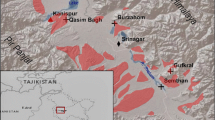Abstract.
The Neolithic and Bronze Age (4400-1570 B.C.) pile dwellings of Concise-sous-Colachoz on the shore of Lake Neuchâtel (Canton of Vaud, western Switzerland), known as an archaeological site for more than 140 years, were recently re-investigated due to rescue excavations. Plant macrofossil analyses were done for several Neolithic occupation phases (3868-2440 B.C. the Cortaillod classique, Cortaillod moyen, Cortaillod tardif and Auvernier periods) with a focus on cereal remains, and additionally, archaeological deposits dating to the Cortaillod moyen culture (3710-3677 B.C.) were studied in detail. The preliminary study of cereal macrofossil remains from all the mentioned Neolithic phases show that the most important cereals were Triticum aestivum/durum/turgidum (naked wheat), T. monococcum (einkorn) and Hordeum vulgare (barley). The preferences for specific crops did obviously not alter significantly through time, but, extraordinarily, significant amounts of einkorn continued to be grown for at least 1400 years during the Neolithic period. Other cultivated plants were Pisum sativum (pea), Linum usitatissimum (flax), and Papaver somniferum (opium poppy). Additionally to the seeds, capsule fragments of opium poppy were found in the Cortaillod moyen deposits. These represent the first finds of uncharred capsule fragments in Europe. Compared with other central European sites, opium poppy was very common during the 38th and 37th cent. B.C. and obviously less appreciated towards the end of the Neolithic in the western part of Switzerland. In central Switzerland the trends seem different: there opium poppy was mainly used during the Late Neolithic period. This may be due to cultural differences within contemporaneous human societies. Wild fruits which were collected as plant resources during the Cortaillod moyen period included Prunus spinosa (sloe), Cornus sanguinea (dogwood), Malus sylvestris (apple), Rubus idaeus/caesius/fruticosus (raspberry/dewberry/blackberry), Fragaria vesca (wild strawberry), Rosa sp. (hip), Quercus sp. (acorn), Corylus avellana (hazelnut), and Fagus sylvatica (beechnut), among others. Compared with other Neolithic sites in westem and central Switzerland the local population of Concise-sous-Colachoz used few sloes, while dogwood fruits were in use throughout the Neolithic period at Lake Neuchâtel.
Similar content being viewed by others
Author information
Authors and Affiliations
Additional information
Received September 4, 2001 / Accepted May 13, 2002
Rights and permissions
About this article
Cite this article
Karg, S., Märkle, T. Continuity and changes in plant resources during the Neolithic period in western Switzerland. Veget Hist Archaeobot 11, 169–176 (2002). https://doi.org/10.1007/s003340200018
Published:
Issue Date:
DOI: https://doi.org/10.1007/s003340200018




